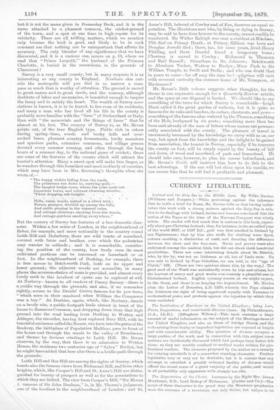CURRENT LITERATURE.
Ireland and the Holy See in the Middle Ages. By Wilkie Nevins. (Williams and Norgate.)—While protesting against the inference that he holds a brief for Rome, Mr. Nevins tells us that having ;leder- taken this work with a. strong animus against the Holy. See in rela- tion to its dealings with Ireland, he has now become convinced that the action of the Popes at the time of the Norman Conquest was wisely taken. The reader will find much that is curious in this book, especi- ally about pre-Christian Ireland; that, for instance, in the so-called year of the world 3657, or 1537 B.C., gold was first smelted in Ireland by one Tighernmas ; that by him also stuffs for clothing were dyed, colours marking a distinction of rank, and denoting the difference between the slave and the free-man. Music and poetry were also cultivated among the ancient Irish, but did not cheek their homicidal proclivities. There are some interesting details about St. Petrick, who, by the by, was not an Irishman at all, but of Latin race. Ho was sent to Ireland by Pope Celestine, we are told, in the "age of Christ," 432. (There are two opinions about this, by the way.) The good seed of the Word was undoubtedly sown by him and.otluans but the harvest of mercy and good works was scarcely a plentiful one. in Christianised Ireland. English tyranny comes, as we might expect, to the front, and there is no denying tho impeachment. Mr. Nevins cites the Letter of Honorius, A.D. 1220, wherein the Pope obtains for Irishmen the right of being appointed equally with Normans to ecclesiastical posts, and protestwagainst the injustioe by which they were excluded.






























 Previous page
Previous page